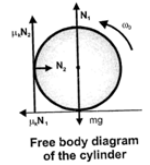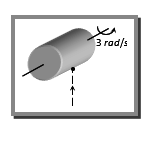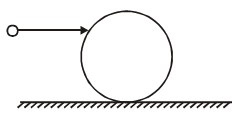11th And 12th > Physics
ROTATION THE LAWS MCQs
:
B
Angular acceleration of the body may not necessarily be zero about any axis about which net external torque is non-zero.
:
B
As the centre of mass of the cylinder does not accelerate, hence ∑F=0
∑Fx=0,N2−μkN1=0 ...(1)
∑Fx=0,N1−μkN2−mg=0 ...(2)
Solving these equations: N1=mg1+μ2k,N2=μkmg1+μ2k
The torque on the cylinder about the axis of rotation
The moment of inertia about axis of rotation 1cm=12mR2
The torque equation T=1α
Using equation ω2=ω20+2α θ, Calculate the angular displacement θ,
Revolution accomplished,
:
A
Initial angular momentum of the system about point O
= Linear momentum × Perpendicular distance of linear momentum from the axis of rotation =Mv(L2)...(i)
Final angular momentum of the system about point O=I1ω+I2ω=(I1+I2)ω
=[M(L2)2+M(L2)2]ω .....(ii)
Applying the law of conservation of angular momentum
⇒Mv(L2)=2M(L2)2ω ⇒ω=vL

:
A
⃗L=⃗r×⃗p=∣∣
∣
∣∣ˆiˆjˆk12−134−2∣∣
∣
∣∣=0ˆi−ˆj−2ˆk=−ˆj−2ˆk and the X-axis is given by i+0ˆj+0ˆk
A solid cylinder of mass 2 kg and radius 0.2 m is rotating about its own axis without friction with angular velocity 3 rad/s. A particle of mass 0.5 kg moving with a velocity 5 m/s strikes the cylinder and sticks to it as shown in figure below. The angular momentum of the cylinder before collision will be 
:
A
Angular momentum of the cylinder before collision L=Iω=12MR2ω=12(2)(0.2)2×3=0.12 J−s.
:
B
As E=L22I⇒E2E1=(L2L1)2=(3L1L1)2 [As L2=L1+200%.L1=3L1]
⇒E2=9E1=E1+800% of E1
:
C
P=τω⇒τ=100×1032π180060=531N−m
:
D
Rotational kinetic energy 12Iω2=12(12MR2)ω2=12(12×10×(0.5)2)(20)2=250J
A hollow sphere of radius 'R' rests on a horizontal surface of finite coefficient of friction. A point object of mass 'm' moved horizontally and hits the sphere at a height of 'R/2' above its center. The collision is instantaneous and completely inelastic. Which of the following is/are correct ?
:
A, C, and D
Impulse due to normal reaction is finite. So friction force gives finite impulse. Therefore frictional torque causes a finite angular impulse about center of mass of system so angular momentum about center of mass of system will change. All other options are correct.
:
D
L=mvxh
⇒L=m(vcos45∘)v2sin245∘2g
⇒L=mv34√2g
Further L=mvxh
⇒L=m(vcos45∘)ho
But h=v2sin245∘2g
⇒v=2√gh
⇒L=mv√22√ghh
⇒L=m√2gh3.

















